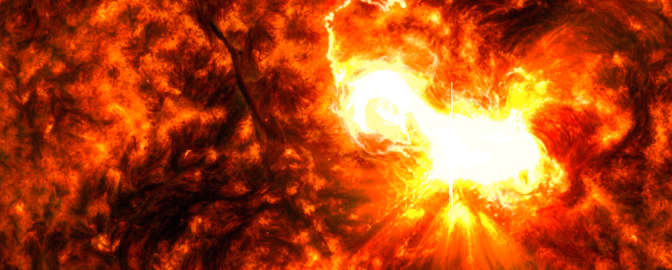Talking to Pluto is hard! Why it takes so long to get data back from New Horizons

Written by
Emily Lakdawalla
January 30, 2015
As I write this post, New Horizons is nearing the end of a weeklong optical navigation campaign. By taking photos of the Pluto system at regular intervals, New Horizons' navigators can precisely measure the observed positions of Pluto and its moons with respect to background stars, and determine the spacecraft's position. The last optical navigation images in the weeklong series will be taken tomorrow, but it will likely take two weeks or more for all the data to get to Earth. Two weeks! Why does it take so long? It's not like it's all that much data: 10 full-resolution LORRI images per day.
The short answer to that question is: Pluto is far away -- very far away, more than 30 times Earth's distance from the Sun -- so New Horizons' radio signal is weak. Weak signal means low data rates: at the moment, New Horizons can transmit at most 1 kilobit per second. (Note that spacecraft communications are typically measured in bits, not bytes; 1 kilobit is only 125 bytes.) Even at these low data rates, only the Deep Space Network's very largest, 70-meter dishes can detect New Horizons' faint signal.

How much data is in a single LORRI image? (LORRI, which stands for Long Range Reconnaissance Imager, is New Horizons' highest-resolution camera.) LORRI's detector is 1024 pixels square. Like many modern space cameras, when the camera reads out its detector, it digitizes each pixel as a 12-bit number. Twelve million is an awful lot of bits, but fortunately LORRI's images are amenable to lossless compression, especially now when they contain mostly black space; they can be zipped up to about 2.5 Megabits without any loss of detail. They can be made even smaller with lossy JPEG compression, but for optical navigation, precision counts; the pictures have to be returned losslessly.
So, do the math. 2.5 Megabits, at 1 kilobit per second: it takes 42 minutes to return one LORRI photo to Earth. Most communications sessions last about eight hours. That's eleven images per communications session. And that assumes that New Horizons is transmitting only LORRI data, which it's not; there are other science instruments and spacecraft housekeeping data, too. The Deep Space Network has only three 70-meter dishes, and there is a lot of competition for time on them; New Horizons is lucky to get one communications session per day. And while New Horizons is pointing its dish at Earth, it can't point at anything else, including Pluto. It has to choose between communicating and taking data.
What all of this means is that whenever New Horizons is actively taking science data, it's building up a data backlog, which it fails to transmit completely in its next communications session. The New Horizons team wants to go into the close encounter phase with data recorders as empty as possible, clearing the decks for all that juicy data from the flyby. What to do?
They have a neat trick that can nearly double New Horizons' data transmission rate, but it comes at a cost of doing simultaneous science. New Horizons' radio system includes two Traveling Wave Tube Amplifiers or TWTAs (pronounced "twittas," like a Bostonian would say "twitters"). The TWTAs amplify the radio signals before they get broadcast from New Horizons' 2.1-meter dish. There are two TWTAs for redundancy: if one fails, the mission will still be able to return data to Earth. But the two TWTAs are not quite identical. One of them transmits radio signals with left-hand circular polarization, and one of them transmits with right-hand circular polarization.
Because they transmit with different polarization, both TWTAs can simultaneously transmit the same data through the dish antenna. On Earth, special hardware at the Deep Space Network can separately receive the two differently-polarized signals, and then combine them to make the signal stronger. Stronger signal means New Horizons can transmit at a higher data rate, about 1.9 times the rate with a single TWTA.
This two-TWTA mode wasn't developed until after launch; they deployed it early in the mission, and it worked well. But radio transmitters are power-hungry. New Horizons' nuclear power source has decayed since it launched nearly a decade ago, and there is no longer enough power to run both TWTAs at the same time as all the other spacecraft subsystems. If they want to nearly double their data rate and reduce their backlog, they need to shut something else down.
Amazingly, they can shut down their guidance and control system and use the saved power to run the second transmitter. But how can you point stably at Earth with your guidance system shut down? The answer is to turn New Horizons from a spacecraft whose orientation stays fixed in space to one that spins. Spinning spacecraft have incredibly stable pointing. It's costly in terms of precious hydrazine fuel to spin up and spin down the spacecraft, so they don't want to make the transition from three-axis to spin-stabilized very often. And you can't take photos from a spinning spacecraft (not with the cameras New Horizons has, anyway). But it's worth it to spend a little hydrazine and quit taking pictures a couple of times in order to get all the approach data down to Earth before the near-encounter phase starts.
So that's why New Horizons is going to spend two long periods of its Pluto approach taking no image data, with the spacecraft spinning and its high-gain antenna pointed at Earth. The two spin periods are scheduled right after trajectory correction maneuvers, rocket-firings that will fine-tune New Horizons' path past Pluto. The first spin period will last from March 10 to April 4; the second lasts from May 15 to May 27. For image fans like me, it'll be a little frustrating to know that Pluto will be getting bigger and bigger, yet New Horizons is not looking. But the consolation is that New Horizons will completely empty its memory on both occasions, sending everything it's got back to Earth, and making room for more and better data. And while the spacecraft is spinning, its particles instruments SWAP, PEPSSI, and SDC can all still take data.
New Horizons should be able to use this two-TWTA communication mode until well after the flyby, assuming, of course, that both transmitters remain healthy. It'll still take more than a year to get all the science data from the encounter back to Earth; it's a lot of data, and a skinny pipe. And it won't be able to use the two-TWTA communication mode forever. Eventually, the output of the nuclear power supply will decay to the point that even while spinning, New Horizons won't have enough power to run both transmitters simultaneously, and we'll be back to using just one at a time. The Kuiper belt object flyby will almost certainly require data return through only one transmitter. New Horizons is a lesson in patience!
--
Here's some further reading on New Horizons' radio downlink. Thanks to New Horizons deputy project scientist Kim Ennico for her help with this entry.
Earth's First Line of Defense
Support the team of astronomers defending Earth with a gift today.
Donate

 Explore Worlds
Explore Worlds Find Life
Find Life Defend Earth
Defend Earth

